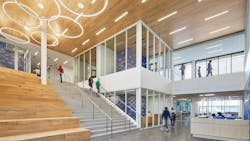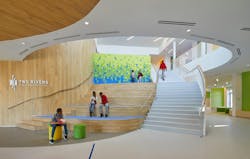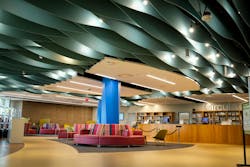The Hidden Power of Sound in Education: Designing Classrooms That Help Students Succeed
Key Highlights
- Acoustic optimization in classrooms can lead to a 25-30% improvement in student comprehension and a 5-10% boost in overall academic performance.
- Materials like recycled PET felt panels offer sustainable, stylish, and effective acoustic treatment options suitable for various educational settings.
- Proper sound management reduces reverberation and noise, creating healthier environments that support effective teaching and learning.
- Integrating acoustic planning early in the design process prevents costly retrofits and ensures spaces meet both aesthetic and functional goals.
- Good acoustics not only improve performance but also contribute to the overall well-being and comfort of students and educators.
The impact of sound cannot be overestimated, especially in spaces dedicated to cultivating the future. Students in acoustically optimized classrooms gain 25-30% improvements in comprehension, with 5-10% boosts in academic performance overall. There’s a reason “nails on a chalkboard” is a saying. Our brains process much more than we consciously know. Spaces can have a profound effect on us. It’s a constellation of subconscious moments that a student or faculty member may not be able to put their finger on. Together, those moments add up to them wanting to be in a space, and acoustics play a huge role in that.
Acoustic design isn’t the same as it was decades ago. For example, in the late ‘90s, universities honed in on having the biggest gyms and better dorms. But today, it’s essential for higher education to create spaces where people can learn how to socialize effectively. In the K-12 realm, creating school spaces that dampen sound is a crucial step in the overall design, as students and faculty shouldn’t have to worry about disturbing the classroom next door.
A designer’s job is to create environments that encourage collaboration and balance the space, optimizing it to be as productive as possible. When designing acoustics for educational spaces, it’s most important to consider the materials being used in the products, the product’s functionality, alongside its aesthetics.
Considerations for Material Selection
There are several factors to take into consideration when selecting materials. Today’s mindful generation of designers prioritizes quality and performance, so material selection has become more critical than ever. Opting for sustainable options, such as those made from recycled PET or reclaimed materials, adds an eco-conscious dimension to the solution.
PET felt panels have emerged as a top choice for acoustic treatment, offering an exceptional solution that meets the needs of any educational setting. It’s made from recycled PET plastic (polyethylene terephthalate), in this case, originating from recycled water and soda bottles. This eco-friendly material transforms into a soft yet sturdy felt that provides excellent acoustic performance. PET panels can be transformed into various applications, including tiles, clouds, partitions, and baffles, and are stylish, functional, and provide an environmentally friendly acoustic alternative.
With the growing market for PET eager to earn a designer’s business, it’s essential to use trusted, third-party certified information to parse out quality from cheap imitators. Look for sustainable certifications that promote product transparency and accurate acoustic testing data. It’s also valuable to consider companies with B Corp status, as it signals a broader commitment to environmental and social standards.
Acoustic Performance Impacts Student Performance
Studies show that good acoustics can improve speech intelligibility by over 35%, directly enhancing learning outcomes, so investing in your acoustics is more than just an aesthetic reason; it’s a performance enhancement. Unfortunately, acoustics are most noticeable when they’re bad. How sound is transmitted is so vital—certain buildings or rooms are designed around it, like auditoriums, amphitheaters, libraries, or common areas. Addressing acoustics in the design as a priority ensures that all students can engage effectively, while reducing vocal strain for educators, creating a healthier and more effective teaching environment.
Sound travels through the air in sound waves. The most common unit of measuring the sound level in a space is the decibel, on a scale of 1 to 140. As sound waves travel through a space and interact with surfaces and objects, they can be diffused, reflected, absorbed, or even blocked. When you can hear sounds reflecting off surfaces, almost competing with other sounds in the space, this is known as reverberation. For example, echoes are a form of reverberation. An important acoustical measure is the Reverberation Time (RT), which is the amount of time it takes for reverberation to decay by 60 decibels.
Acoustic tiles, baffles, carpets, draperies, and upholstered furniture can work together to manage sound reverberation. Adding acoustic panels from 3-7 feet off the floor is particularly effective, as it targets the height where most sound waves from human activity occur.
Noise Reduction Coefficient (NRC) is a numeric rating of the level of sound absorption of a given surface. NRC normally ranges from 0-1.0 (0 being no absorption and 1.0 being almost perfect absorption). However, there are cases where the NRC rating can exceed 1.0, as the coefficient is not a percentage, and multiple surface areas can contribute to an overall NRC increase. Materials that are thicker and more porous will have higher NRC ratings and have a better acoustic performance.
When Sound Meets Style
Beautiful spaces must be both visually and acoustically harmonious to provide true comfort and functionality. Think about it like this: a space with excellent sound quality but a jarring visual design provides a less pleasing overall experience for the end user. As it turns out, humans actually perform better in well-designed spaces. A student’s performance isn’t determined only by teachers, curriculum, or effort, as 16% of the variance in student test scores was tied to design variables—lighting, air quality, sound, temperature, connection to nature, flexibility, and more. It’s important to understand how the design impacts someone when they see it, move through it, and experience it acoustically, as experiencing design involves multiple senses.
Acoustics with air gaps designed on them may not be visible, but their impact on the environment is profound. Not only are they visually aesthetic, but these intentional voids within or behind acoustic panels and products enhance sound absorption, transforming the way a space feels and functions. Air-gap-optimized products are particularly effective in spaces where both acoustics and aesthetics are paramount. Whether it’s a high-traffic area or a large-scale installation, air-gap solutions seamlessly blend form and function, offering transformative possibilities for architects and designers.
Acoustic planning should begin at the earliest stages of architectural design to avoid costly retrofits and ensure long-term success. Integrating sound management from the start allows architects and designers to create spaces that meet both functional and aesthetic goals.
Today’s educational spaces are being reimagined and redesigned to do more than just house students—they are crafted to be environments that foster focus, collaboration, and well-being. And in these dynamic spaces, acoustics are a powerful design tool. Whether you’re shaping a bustling corridor, a flexible library zone, or a large-scale auditorium, thoughtful acoustic design enhances how students engage, learn, and succeed.
About the Author
Michael DiTullo
Michael DiTullo, Head of Product Innovation for Carnegie Acoustic Solutions, has been designing iconic products for some of the world’s biggest brands for more than 20 years. He has worked with Nike, Google, Honda, Timex, Chantal, Converse, Motorola and has been collaborating with Kirei since 2019. Prior to starting his eponymous design studio, Michael was Chief Design Officer for Sound United, parent company of Denon, Marantz, Polk, and Definitive Technology, where he oversaw industrial design, UX, packaging, product management, and marketing creative. He also spent several years as creative director for frog design’s San Francisco studio and nearly a decade at Nike where he worked directly with Michael Jordan, Carmelo Anthony, Derek Jeter, and Dwayne Wade.
DiTullo has sat on the ascensions board to SFMoMA, the board of directors for The Design Foundation and is a strategy advisor to Offsite, a disruptive take on design education. Michael’s work has won numerous awards and has been printed in publications like Metropolis and Wallpaper. He has been featured in the books “Dieter Rams: As Little Design As Possible” and “Breaking In” and has published his own book “365: One Year Of Design Sketching Every Day”. In 2017 DiTullo founded “Real Designers Ship” and organization dedicated to celebrating designer’s whose work makes it into production. Michael is listed on over 30 patents and has won numerous awards including the IDSA’s special lifetime achievement award for contributions to the design industry, an award won by design luminaries such as Jonathan Ive, Charles Eames, and Raymond Loewy.
When Michael was 13 years old he said “I want to draw stuff from the future” for a living, and that is still the best description for what he does.


